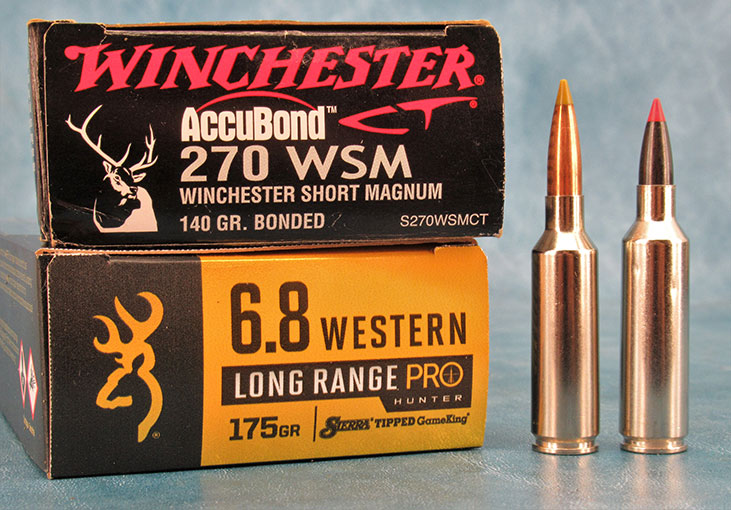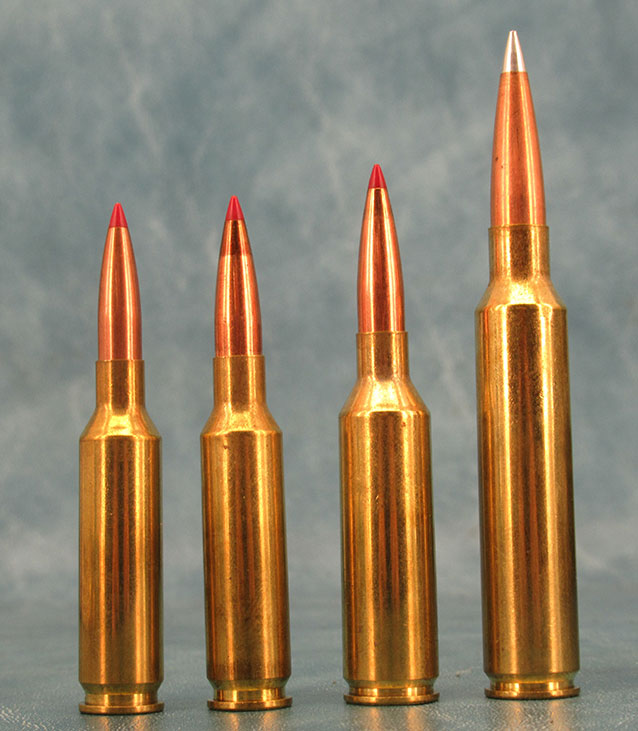Guns & Ammo – A Look At The New 6.8 Winchester Western Cartridge
There’s a new short-action cartridge in town and it’s called the 6.8 Winchester Western. If you’re metric savvy, you know that works out to .277-inch, which of course is the same bullet diameter as the 96-year-old .270 Winchester.

But Winchester already has a short-action .270 in the .270 WSM, you’re probably saying to yourself, especially when I tell you it’s based on the same case as the WSM and that the only change is that its body is shortened by about .085-inch. A shorter body means less powder capacity, right? Which means it has commensurately less ballistic potential than the WSM version, right? Well…yes.
The 6.8 Western belongs to the relatively new school of thought predicated on the concept that cartridges of modest capacity for the caliber, pushing highly streamlined bullets heretofore considered too heavy for the caliber, make for more efficient and more accurate long-range cartridges.
Other membership requirements are that bullets be seated further out so as not to infringe on usable powder space. And because these bullets are so long and heavy for the caliber, they are launched at less than magnum velocities through barrels having faster than established twist rates.
The 6mm and 6.5 Creedmoor, and the 6.5 and .300 PRC are examples of this thinking, and all were the work of Hornady. As counterintuitive as it sounds, these rounds have proven equal or superior in extreme range competitive events once dominated by .300 and .338 magnums. Less recoil is also an integer in the long-range shooting equation because it is axiomatic that rifles that recoil less can be shot more accurately.
The 6.8 Western, then, is the newest member of this growing school of thought which kneels at the altar of “Long Range.” Initially, four factory loads are being offered, three by Winchester and one by Browning.

For the following table I used Winchester’s published ballistic data for their factory loadings to show how the Western compares with their .270 WSM. You’ll note that Winchester’s heaviest WSM loading is a 150-grain bullet, while the lightest 6.8 loading is165. When there are no common bullet weights for direct comparison, attempting to do so is like comparing apples to watermelons. Still, it’s the only basis of comparison we have.
6.8 Western .270 WSM
165 gr. Accubond LR — 2970 fps 130 gr. Ballistic Silvertip — 3275 fps
170 gr. Ballistic Silvertip — 2920 140 gr. AccuBond CT — 3200
175 gr. Sierra Gameking – 2835 150 gr. Ballistic Silvertip — 3120
You’ll also notice that the bullet weights for the WSM are in 10 grain increments, while the much heavier Western payloads increase by only 5 grains. Just noting the bullet weights, you’d think we were comparing different bore sizes!
To stabilize those l-o-n-g bullets, the Winchester Model 70 and the XPR rifles being offered in 6.8 Western have 1-8” twist rates, while the Browning X-Bolts have1-7.5”. Why the difference? The 175-grain is a Browning load, which suggests that 170 will be the heaviest load being offered under the Winchester label.
Interestingly enough, Sierra didn’t make a 175-grain .277” bullet; it was developed specifically for Winchester and the 6.8 Western. At the time of this writing only two Winchester loads were available for testing and both came in labeled white boxes; only the Browning 175 Tipped Gameking load was in the appropriate packaging, and a handsome and useful box it is, with velocity, energy and trajectory data for 100 and 200-yard zero ranges out to 1,000 yards! Unfortunately, however, a test rifle of either brand did not arrive for test firing in time to make this deadline.
So, what does the 6.8 Western do that the .270 WSM can’t, if anything? If we’re to believe what’s claimed, the answer is in its long-range performance. Well, let’s see. I think the most logical option is to compare the heaviest factory loads in each caliber – 150-grain in the WSM, and 175 in the 6.8 Western — and we’ll do it using Hornady’s Ballistic Calculator because Winchester’s ballistic tables only go to 500 yards.

The G1 Ballistic Coefficient (BC) of the 150-grain Ballistic Silvertip used in the Winchester WSM factory load is .496, while the 175-grain Sierra Gameking’s in the 6.8 is .617. Big difference! To level the playing field, we have to compare bullets of similar BC, so I chose to substitute Nosler’s 150-grain AccuBond CT with a BC of .625. A difference of .008 is negligible (Nosler makes a 160-grain Partition, but it has a BC of only .434).
6.8 Western; 175 gr. Sierra Gameking @ 2835 fps.
500-yard velocity (fps) 500-yard energy (ft. lbs.) 500-yard trajectory (inches) 500-yard wind drift (10mph crosswind)
2149 1794 -39.8 13.9 inches
1000-yard velocity (fps) 1000-yard energy (ft. lbs.) 1000-yard trajectory (inches) 1000-yard wind deflection
1574 963 -273 64.6 inches
.270 WSM: 150 gr. Sierra Gameking @ 3120 fps.
500-yard velocity (fps) 500-yard energy (ft. lbs.) 500-yard trajectory (inches) 500-yard wind drift (10mph crosswind)
2400 1918 -32 12 inches
1000-yard velocity (fps) 1000-yard energy (ft. lbs.) 1000-yard trajectory (inches) 1000-yard wind deflection
1787 1064 -218.2 54.9 inches
Now I realize one can pick and choose statistics to arrive at almost any conclusion one desires, but the cold hard fact is that the .270 WSM can not only outperform the 6.8 Western at 500 yards, but at 1,000 as well, where those heavier bullets are supposed to overtake the lighter ones.
As for accuracy, there’s no denying that changes in cartridge design — bullet seating, chamber throat and leade specs — along with better rifles, all contribute to better accuracy on average with factory rifles and ammunition.
If you’re a handloader, however, you can even improve on factory .270 WSM ballistics by building a custom rifle on a standard-length action and having the barrel long throated to where you can seat bullets out where they belong.
By so doing you effectively increase powder space, hence potential velocity. I’ve been building rifles like this all my life. When I developed my wildcat 7mm JRS based on the .280 Rem. case back in the late `70s, I used Remington 700, Winchester Model 70 and Sako L61 long actions, all are of magnum-length (3-5/8” magazines). I also built a couple .284 Winchesters on Ruger’s standard-length action (3.3” magazine) rather than the short 2.8” actions it was designed and loaded for in factory ammo.
Then when the WSMs came along in 2001, I did the same thing using Winchester Model 70 and Montana Model 1999 actions, both of which have magazines allowing for cartridge lengths of 3.120”.

Anyway, as for the rifles being offered by the respective companies in 6.8 Western, I’m sure virtually all of you out there are familiar with Winchester’s Model 70 and XPR, and Browning’s X-Bolt, so no need for descriptions. As already noted, the short Model 70 action can digest cartridges 3.12” in overall length. The Browning X-Bolt and Winchester XPR can handle cartridges of 3.0” (2.955” OAL is what factory 6.8 ammo measures).
Conclusions? If you’re a factory rifle/factory ammo user the 6.8 Western may have some appeal. However, in gear head parlance, there’s no substitute for cubic inches, and that applies for cartridge cases as well as racing engines.
Granted, there is a point of diminishing return when you increase case size beyond so-called “bore capacity,” but with today’s powders neither of these .270s is near that threshold. The simple fact that the WSM case has a 5-6 percent larger combustion chamber than the Western means that, all other things equal, it can launch bullets at higher velocities.–Jon R. Sundra

